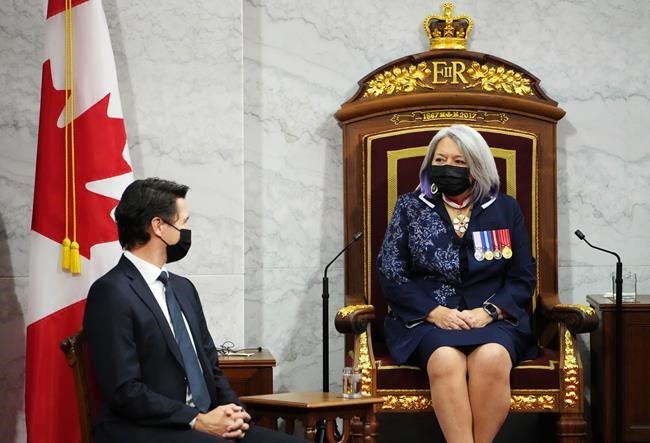OTTAWA — Gov. Gen. Mary Simon, the first Inuk person to serve in the role, centred the theme of reconciliation with Indigenous Peoples in Tuesday's speech from the throne with an introduction — delivered in English, French and Inuktitut — that she had written herself.
"I encourage you to seek out the truth, and to learn about the lived realities in First Nations, Inuit and Métis communities," Simon said in the speech delivered in the Senate chamber.
"Although each community is distinct, we all share a desire to chart a way forward together towards reconciliation."
She also touched upon the finding by First Nations of hundreds of unmarked graves on the sites of former residential schools across Canada earlier this year.
"We cannot hide from these discoveries. They open deep wounds," she said in French.
At the same time, she said there is hope.
"Reconciliation is not a single act, nor does it have an end date. It is a lifelong journey of healing, respect and understanding," she said.
Simon, who was born in Kangiqsualujjuaq, in the Nunavik region of northern Quebec, is a well-known advocate for Inuit culture and rights. She has served as the president of Inuit Tapiriit Kanatami, a national advocacy organization for Inuit. She was also Canada's ambassador to Denmark and the Canadian ambassador for circumpolar affairs.
When she was named as Governor General in June, she responded to questions about her lack of fluency in French by saying she was denied the chance to learn the language while attending federal government day schools as a child.
Throne speeches are written by the Prime Minister's Office but governors general can add some lines of their own.
The speech from the throne has the Liberal government promising to bring together all levels of government as well as Indigenous Peoples to attract business to Canada.
It says federal government will continue to respond to the calls to action from the Truth and Reconciliation Commission, which investigated the history and harmful legacy of residential schools in Canada, by creating a national monument to honour survivors. It will also name a special interlocutor to seek justice on residential schools.
At the intersection of mental health and Indigenous Peoples, the government will invest in a mental health and wellness strategy that is distinctions-based — meaning that it will take into account the different needs of First Nations, Inuit and Métis — and guided by Indigenous Peoples, residential school survivors and their families.
The government is also committing to work to remedy the issue of Indigenous family separation by the child-welfare system, while ensuring compensation for those harmed by those services.
The speech says the government will speed up action in collaboration with Indigenous partners to address the national crisis of missing and murdered Indigenous women, girls and LGBTQ people.
It also says reconciliation requires a "whole-of-government" approach, breaking barriers and creative strategies for accelerating the work that needs to be done.
The government is also pledging to help close the gaps that First Nations, Inuit and Métis communities continue to face, mentioning the standing long-term drinking water advisories and putting in place the United Nations Declaration on the Rights of Indigenous Peoples.
Lynne Groulx, CEO of the Native Women's Association of Canada, said that while the speech's theme of reconciliation came through clearly, she is concerned about whether those commitments will be executed with meaningful action.
One example of the federal government's lack of concrete action on reconciliation, said Groulx, is its action plan in response to the national inquiry into missing and murdered Indigenous women and girls.
"We have concerns that what they're going to do again, is take some funding that is very short term, put it on the table, and it's not going to be what's actually needed, which is a long-term investment in resolving some of these issues," she said.
Groulx said: "If the government in the day had enough money to build all those residential schools, they need to find the funding now to build as many places that we need for healing and fix some of the problems here."
She said instead of taking action through top-down bureaucratic systems, the government should empower organizations that work with Indigenous communities and have Indigenous-led and elder-led solutions.
Bloc Québécois Leader Yves-François Blanchet said in French that in the throne speech, the government used a lot of buzzwords including references to Indigenous peoples, but it was light on substance and detail on concrete steps.
Conservative Leader Erin O'Toole said his party is there to be the voice of Canadians on a number of issues, including those who want "to see real progress on the path to reconciliation and not just symbolic gestures."
In his response to the throne speech, NDP Leader Jagmeet Singh did not comment specifically on the commitments on Indigenous reconciliation, but said the Liberal government is one that "has run out of ideas, and run out of steam."
This report by The Canadian Press was first published Nov. 23, 2021.
———
This story was produced with the financial assistance of the Facebook and Canadian Press News Fellowship.
Erika Ibrahim, The Canadian Press




